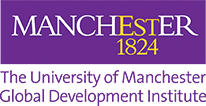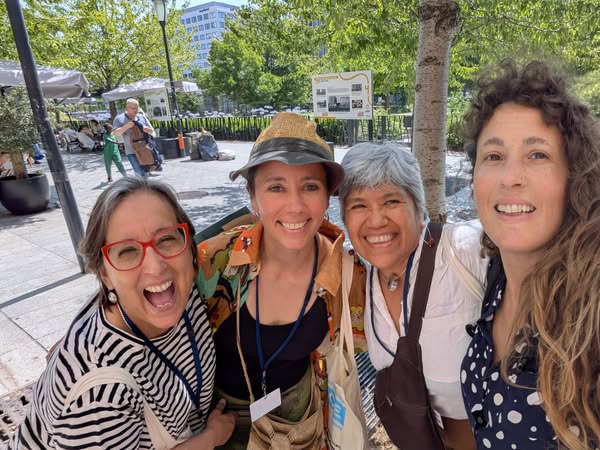by Tanja Bastia, Erika Busse, Verónica Montes, and Andrea Souto Garcia
At the 25th IMISCOE conference, the largest migration conference in Europe, recently held in Paris, we (the authors) took the opportunity to meet and discuss our respective research experiences, using the migrant body as an entry point to guide our discussion.
The roundtable, organised by Tanja, aimed to explore how we can use the migrant body as an entry point to decentre migration studies, which was the main focus of the conference. How can we move beyond dominant theories and understandings of migration? The main migration theories are largely based on European and North American experiences of South-North migration and mainly produced in higher income countries of the Global North. The session asked what we could know differently about migration and migrants, if we started our inquiry from the point of view of the migrant body.
We recognised that migrants by definition use their bodies to move across space, whether this is a move within or across national borders. Migration entails embodied experiences, whether these relate to crossing borders, negotiating access to jobs and services, experiences of violence or of pleasure and joy.
We also recognised that bodies are culturally understood and that these understandings can change through migration.
Bodies are also multi-dimensional, including not just the physical dimension, but also emotional, mental and spiritual dimensions, whether these are recognised or not.
We took inspiration from queer, Chicana writer Gloria Anzaldúa, who placed the body at the centre of her writing. She also argued that spirituality is an essential dimension of our being and can provide the bridge for connecting to other people, the other-than-human, and is essential for finding support for oneself as well as solidarity towards others.
While it might be easy to slip into an individualistic and inward-looking experience of migration, we recognised how individual experiences are shaped by structural inequalities, including racism, xenophobia, and misogyny. Yet migrants use their multi-dimensional bodies to resist and sometimes also overcome these structural constraints.
Tanja’s interest in the migrant body started a few years ago, while she was working on South-South migration with an international team of researchers, while also training as a Shiatsu and Holistic Acupressure practitioner. While initially keeping academia and her body-work practice separate, she started looking for ways to bring the two practices together and is now exploring the extent to which the migrant body facilitates such bridging (see Conference on the Migrant Body coming up in December in Manchester, generously funded by the British Academy and the UoM Hallsworth Fund (CFP now closed and photo competition, still open).
In their interventions, the speakers highlighted how migrants use the body to resist hegemonic violence. This resistance takes different forms and can look very different, depending on whether this resistance takes place in public or in private spaces. They also spoke about their role as migration researchers who are migrant themselves (Erika, Verónica) and also how one’s body changes while conducting fieldwork in different landscapes and the printed race, class and gender meanings are distorted by the gaze of others (Andrea).
Erika’s work shadowing Peruvian women in New Jersey and Minnesota reveals that women often resort to folk dance at public events as a means of cultural transmission for their community (see here and here). They also do it for building a space for themselves in a society that racializes them, as well as a space of joy and camaraderie, particularly in the rehearsal space. Furthermore, while they perform at Peruvian events in these two states, they do so in spaces that cater to the larger society. Thus, dance is not just for cultural reproduction, but a tool to be seen, albeit through a white gaze, and performing the “good immigrant”.
We, as researchers, conduct our research using our entire bodies. Erika, as part of her ethnographic work, has been dancing and sometimes performing with the Minnesota dance group for the past eight years.
Andrea´s work (see here and here) explores the body’s borderisation processes that Brazilian and Colombian women experience in their migrations to Spain and Portugal. By understanding the body as something unstable/insecure, she approaches the transformations that these migrant women embody while crossing frontiers, as well as the bodily resistance strategies that they put into play in different postcolonial landscapes. It is through the creation of a collective body of knowledges and practices of resistance, which have circulated from generation to generation, in a rumour network woven from mothers to daughters, between sisters, neighbours and friends that women have been able to pursue their migration projects.
Being aware that their bodies are unstable/insecure, Colombian and Brazilian migrant women skilfully stress sexual and racial borders to make them visible when convenient –behaving, walking, speaking, dressing in expected ways–, or, invisible when inconvenient -dressing down, simple, avoiding make up, changing their accent…- so as to drift apart from colonial pornotropical stereotypes. Through these reappropriation/denial strategies, women have managed to upgrade in the labour, marriage and political markets at their destinations – getting better jobs, accessing local networks and cultural resources, gaining permits or citizenship-, thus overcoming the global restrictions on their geographical and social mobility.
Verónica’s latest research work, conducted in collaboration with Erika Busse, has focused over the last six years on the experiences of a group of Mexican immigrant women who, after living for years in the U.S., were violently separated from their families due to deportation. Drawing on what sociologist Abrego defines as accompaniment, which succinctly entails an open and acknowledged emotional positioning in the pursuit of producing more honest and ethical research (Abrego, 2021), Veronica’s research has shed light on how these women and their families have reconfigured their lives in response to deportation. More importantly, and to the theme of this roundtable, Veronica’s discussion focused on the strategies these women developed to cope with their traumatic experience.
For these women, one of those coping strategies was the creation of a space of encuentro (encounter), where other women who had gone through the same experience of family separation due to deportation could come together and support each other by just being together. Here, the dimension of what Ennes (2020) refers to as the migrant-body is crucial. Drawing on Bourdieu’s concept of embodiment, Ennes invites us to deepen the theoretical discussion of the migrant’s body in the phenomenon of migration. Not only were these women’s bodies that lived the traumatic experience of deportation, but it is precisely their bodies that, after a period of numbness, were able to feel hopeful again. Being together and more importantly listening to each other’s stories, these women realized they were not alone. At the beginning of these encuentros, these women shared the space and acknowledged their presence and existence without needing to say a word. As time passed, these women began sharing their stories, and in doing so, they were able to make sense of what they had gone through, which helped them move on from the disoriented phase caused by deportation (Montes and Busse forthcoming Testimonios as a Tool of Family and Collective Memory: The Case of Dreamers Moms in Tijuana, Mexico. In Johanna Leinonen, Seija Jalagin, Outi Kähäri, Ilmari Leppihalme, Hanna-Leena Määttä & Elina Turjanmaa (Eds). Displaced Families, Dispersed Memories. The Helsinki University Press 2026).
It is not only their bodies that allow migrants to move, but also those that resist the symbolic and structural violence they face during their journeys as they try to reach their final destination. Above all, it is their bodies that sustain the emotional and spiritual strength to continue forward in pursuit of their desired individual migration project.
The lively discussion that followed touched upon many of the points that were opened up by the initial speakers’ interventions. The audience contributed their own reflections on how we might challenge the colonial gaze that is constantly being reproduced in the media and at the border.
Community emerged as an important topic, particularly in relation to how as migrants, we might choose to engage with communities of migrants by offering our bodies at the service of migrant organisations – cleaning squats or community spaces, cooking food or chasing mice. Whatever needs doing.
Temporality also emerged as relevant, particularly as migrant bodies age over time and what this might mean for migrants and the opportunities that might open, or close, to them.
While some of the plenary sessions at the conference called for ‘the end of migration studies’, this roundtable confirmed the importance of recognising the corporality of migrants and their right to be in the spaces that they inhabit, because of the wide contributions they make, not just through work, but also culture, language, and spirit. At a time when migrant bodies are being forcefully detained and expelled from some of the richest countries in the world, our panel celebrated everything that migrants contribute by enriching the places they move through and to.
Pictured (left to right): Erika, Tanja, Verónica, and Andrea
Note: This article gives the views of the author/academic featured and does not necessarily represent the views of the Global Development Institute as a whole.
Please feel free to use this post under the following Creative Commons license: Attribution-NonCommercial-NoDerivatives 4.0 International (CC BY-NC-ND 4.0). Full information is available here.

